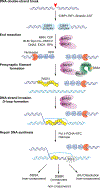The BRCA Tumor Suppressor Network in Chromosome Damage Repair by Homologous Recombination
- PMID: 30917004
- PMCID: PMC7004434
- DOI: 10.1146/annurev-biochem-013118-111058
The BRCA Tumor Suppressor Network in Chromosome Damage Repair by Homologous Recombination
Abstract
Mutations in the BRCA1 and BRCA2 genes predispose afflicted individuals to breast, ovarian, and other cancers. The BRCA-encoded products form complexes with other tumor suppressor proteins and with the recombinase enzyme RAD51 to mediate chromosome damage repair by homologous recombination and also to protect stressed DNA replication forks against spurious nucleolytic attrition. Understanding how the BRCA tumor suppressor network executes its biological functions would provide the foundation for developing targeted cancer therapeutics, but progress in this area has been greatly hampered by the challenge of obtaining purified BRCA complexes for mechanistic studies. In this article, we review how recent effort begins to overcome this technical challenge, leading to functional and structural insights into the biochemical attributes of these complexes and the multifaceted roles that they fulfill in genome maintenance. We also highlight the major mechanistic questions that remain.
Keywords: BARD1; BRCA1; BRCA2; DNA damage repair; genome maintenance; homologous recombination; replication fork protection; replication fork repair; tumor suppression.
Figures




References
-
- Lindahl T, Barnes DE. 2000. Repair of endogenous DNA damage. Cold Spring Harb Symp Quant Biol 65: 127–33 - PubMed
-
- Hoeijmakers JH. 2009. DNA damage, aging, and cancer. N Engl J Med 361: 1475–85 - PubMed
-
- Ashworth A, Lord CJ. 2018. Synthetic lethal therapies for cancer: what’s next after PARP inhibitors? Nat Rev Clin Oncol 15: 564–76 - PubMed
Publication types
MeSH terms
Substances
Grants and funding
LinkOut - more resources
Full Text Sources
Medical
Research Materials
Miscellaneous

